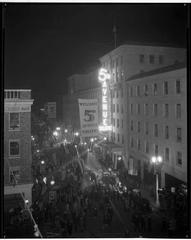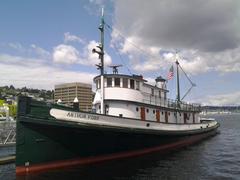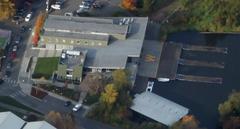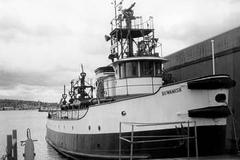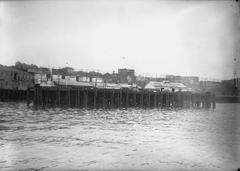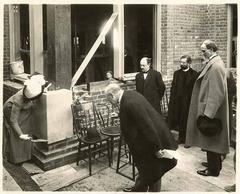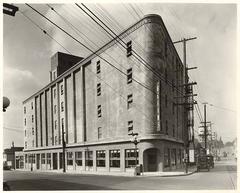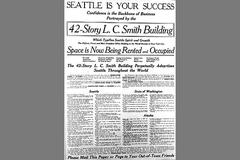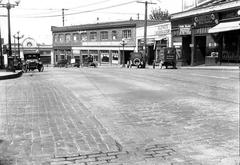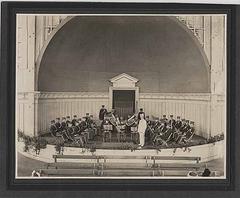
Drumheller Fountain Seattle Visiting Hours, Tickets, and Travel Guide
Date: 04/07/2025
Introduction
Drumheller Fountain, affectionately known as “Frosh Pond,” is a historic and visually striking centerpiece of the University of Washington (UW) Seattle campus. Created as the focal point of the 1909 Alaska-Yukon-Pacific Exposition (AYPE), this iconic fountain is renowned for its grand design, panoramic views of Mount Rainier, and its enduring role in campus life. With free, year-round access, Drumheller Fountain attracts students, locals, and tourists seeking a blend of natural beauty, architectural heritage, and rich Seattle history.
This comprehensive guide covers everything you need to know about visiting Drumheller Fountain, including hours, accessibility, tips for a memorable visit, and nearby attractions. For more on its history and significance, see the UW Libraries AYPE Legacy Exhibit and the UW Facilities blog.
Table of Contents
- Introduction
- Location and Accessibility
- Visiting Hours & Admission
- History and Legacy
- Campus Life and Traditions
- Environmental and Community Significance
- Practical Visitor Tips
- Nearby Attractions
- Best Times to Visit
- FAQ
- Weather and Sustainability
- Plan Your Visit
- References
Location and Accessibility
Drumheller Fountain sits at the southern end of Rainier Vista, near the geographic heart of the UW Seattle campus. It is easily accessible:
- By Public Transit: Multiple King County Metro bus lines and the Link Light Rail (University of Washington Station) serve the University District, with a short walk to the fountain.
- Parking: Visitor parking is available in nearby garages such as Central Plaza and Padelford, though spaces are limited during events.
- On Foot/Bike: The campus is pedestrian-friendly, with paved, gently graded paths suitable for wheelchairs and strollers. Accessibility maps and resources are available (UW Accessibility).
Visiting Hours & Admission
- Hours: Drumheller Fountain is an outdoor, public space accessible 24/7, year-round. For safety and the best experience, visiting during daylight hours is recommended.
- Admission: Free. No tickets are required to visit.
- Guided Tours: General UW campus tours typically include the fountain. Check the Visitor Center or UW Events calendar for details.
History and Legacy
Origins and Early Development
Constructed for the 1909 Alaska-Yukon-Pacific Exposition as “Geyser Basin,” Drumheller Fountain was designed by the Olmsted Brothers, who envisioned a grand, axial campus layout culminating in unobstructed views of Mount Rainier (Livabl; The Clio). The fountain’s placement and landscaping remain a testament to early 20th-century urban planning.
Naming and Symbolism
Originally called “Frosh Pond,” the fountain was renamed in honor of Joseph Drumheller, a prominent UW regent and benefactor. Today, it stands as a symbol of continuity between the university’s past and present, and its alignment with Rainier Vista and Mount Rainier is intentionally designed to inspire awe (UW Facilities).
Enduring Legacy
The fountain anchors the campus’s iconic Rainier Vista and is surrounded by historic buildings such as Suzzallo Library and Denny Hall. Its presence is a lasting legacy of the AYPE, which drew over 3.7 million visitors and shaped both campus and city (UW Libraries).
Campus Life and Traditions
Drumheller Fountain is deeply woven into UW’s culture. It is a favorite backdrop for graduation photos, celebratory gatherings, and student traditions. Its nickname, “Frosh Pond,” recalls early 20th-century initiation rituals. Today, the fountain remains a communal space for reflection, protest, and spontaneous celebration (Wikipedia; The Tourist Checklist).
The area comes alive during spring (cherry blossom season), summer (graduations, outdoor events), and fall (return to classes), offering visitors a chance to experience authentic campus energy.
Environmental and Community Significance
The fountain serves as an urban oasis, home to ducks and other wildlife. Each spring, a duckling ramp is installed to help young birds access the water safely (UW Facilities). Maintenance is a community effort, involving staff and students in preserving the fountain’s ecological and historical integrity.
Practical Visitor Tips
- Navigation: The closest navigation address is 3900 Rainier Vista NE, Seattle, WA (Trek Zone).
- Facilities: Restrooms, water refill stations, and benches are available in nearby buildings like the Husky Union Building (HUB), Suzzallo Library, and Odegaard Undergraduate Library (HFS UW).
- Food: The HUB features a food court, cafes, and access to food trucks. The University District offers diverse dining options (UW Dining).
- Safety: The campus is well-patrolled; exercise caution during inclement weather as paths may be slippery (Wikipedia).
Etiquette
- Don’t swim or wade in the fountain.
- Keep pets leashed and clean up after them.
- Respect ongoing events, especially during graduation season.
- Stay on designated paths to protect landscaping and wildlife.
Nearby Attractions
- Suzzallo Library: Architectural gem with a grand reading room.
- Burke Museum of Natural History and Culture: Pacific Northwest heritage exhibits (Burke Museum).
- Henry Art Gallery: Contemporary art installations (Henry Art Gallery).
- Washington Park Arboretum: Expansive botanical gardens (UW Botanic Gardens).
- University District: Shopping, dining, and nightlife.
- Off-campus: Pike Place Market, Space Needle, and Gas Works Park are accessible by public transit (Lonely Planet; Tripalink).
Best Times to Visit
- Spring: Late March to early April for cherry blossoms (The Tourist Checklist).
- Summer: June–September for best weather, outdoor events, and lush landscaping (Travellers Worldwide; Treksplorer).
- Fall: Crisp air and colorful foliage.
- Winter: Quiet atmosphere, but bundle up for rain and cooler temperatures (Lonely Planet).
FAQ
Q: What are Drumheller Fountain’s visiting hours?
A: Accessible 24/7, year-round. Water jets operate seasonally, usually late spring through early fall.
Q: Is there an admission fee or ticket required?
A: No, admission is free.
Q: Are pets allowed?
A: Yes, if leashed and under control.
Q: Is the site wheelchair accessible?
A: Yes, there are ramps and paved paths (UW Accessibility).
Q: Are guided tours available?
A: Yes, most UW campus tours include the fountain (Admit UW).
Q: Can I swim or wade in the fountain?
A: No, this is prohibited for safety and preservation (Wikipedia).
Weather and Sustainability
Seattle’s climate is mild, with dry, warm summers and rainy, cool winters. Dress in layers and carry a rain jacket outside summer months. The University of Washington is committed to sustainability; use available recycling and compost bins, and refill water bottles at campus stations (HistoryLink).
Plan Your Visit
- Arrive early for the best photos and to avoid crowds in peak seasons.
- Use public transit for convenience.
- Check the UW events calendar to align your visit with campus happenings.
- Respect campus rules to help preserve this historic landmark.
For interactive maps, virtual tours, and real-time updates, download the Audiala app and follow UW’s official social media.
References and Useful Links
- 12 Photos of History: University of Washington Architecture (Livabl)
- Drumheller Fountain Entry (The Clio)
- UW Libraries AYPE Legacy Exhibit
- Draining Drumheller Fountain (UW Facilities blog)
- A Brief History of UW Campus Development (Daily UW)
- UW Visit Page (Admit UW)
- University of Washington Campus (The Tourist Checklist)
- University of Washington Official Site
- HistoryLink - UW Campus
- Dining Locations (UW Housing & Food Services)
- UW Disability Resources
- UW Accessibility
- Trek Zone - Drumheller Fountain
- Wikipedia - Drumheller Fountain
- Travellers Worldwide - Best Time to Visit Seattle
- Treksplorer - Best Time to Visit Seattle
- Lonely Planet - Best Time to Visit Seattle
- Burke Museum
- Henry Art Gallery
- UW Botanic Gardens
- Tripalink - Fun Places near UW
Experience the grandeur and community spirit of Drumheller Fountain—one of Seattle’s most beloved historic landmarks. For more travel tips and interactive guides, download the Audiala app and follow us online.

